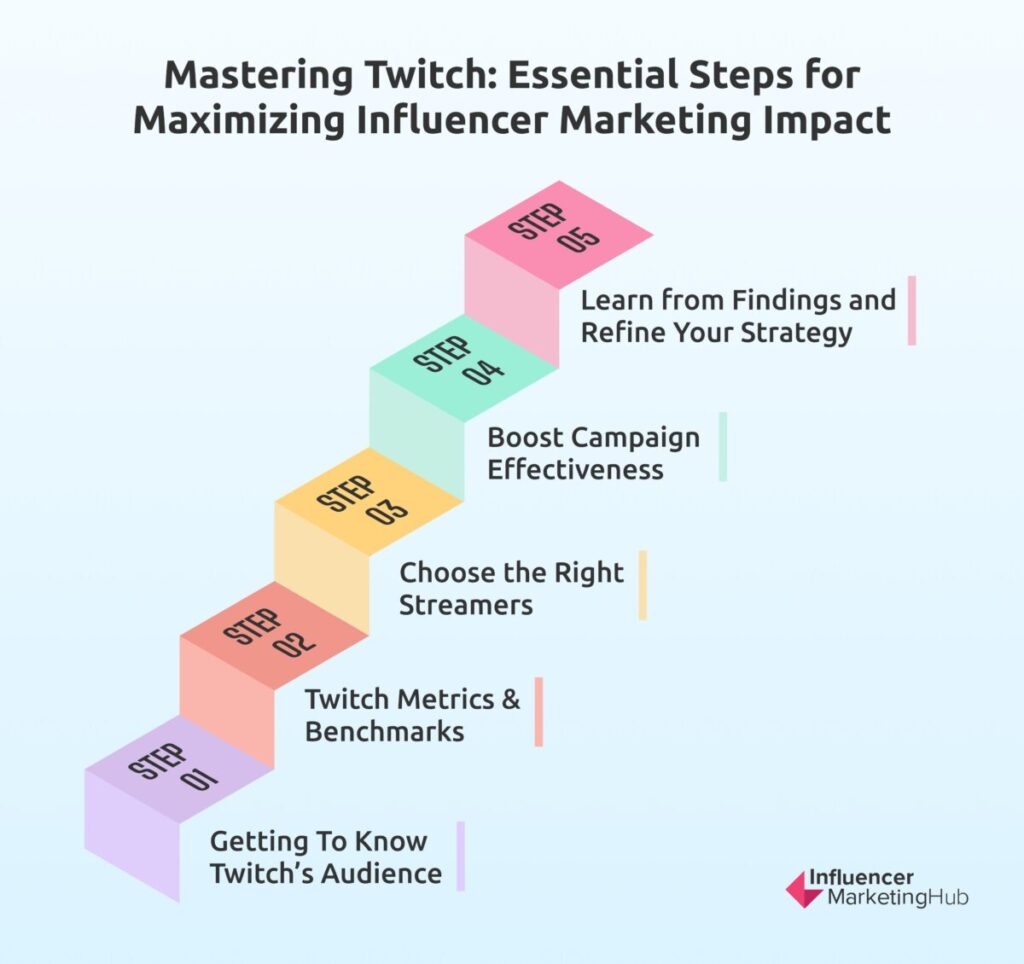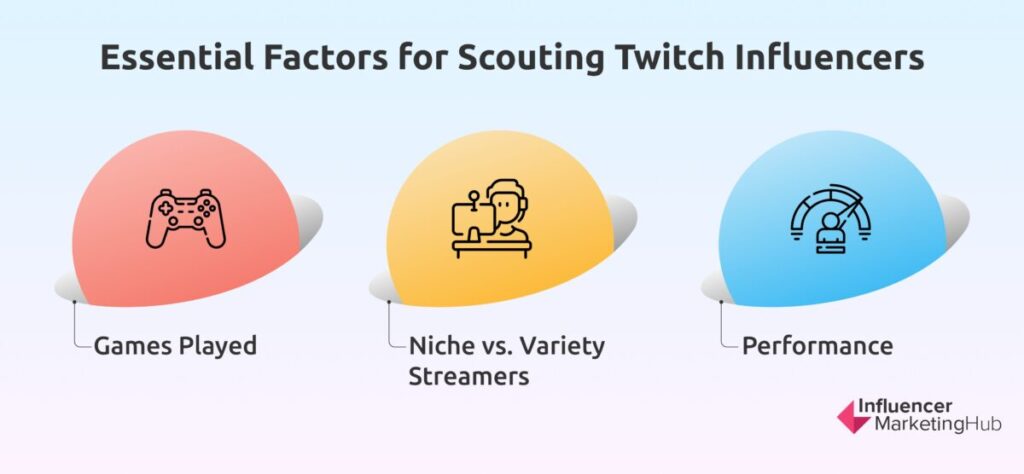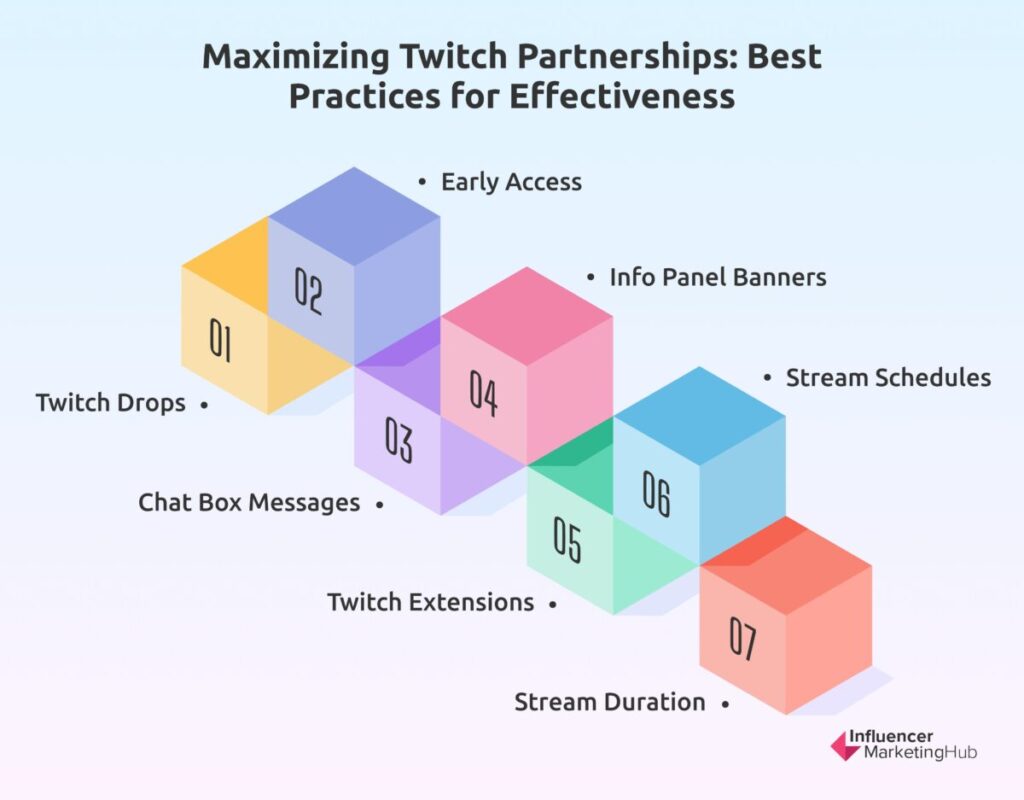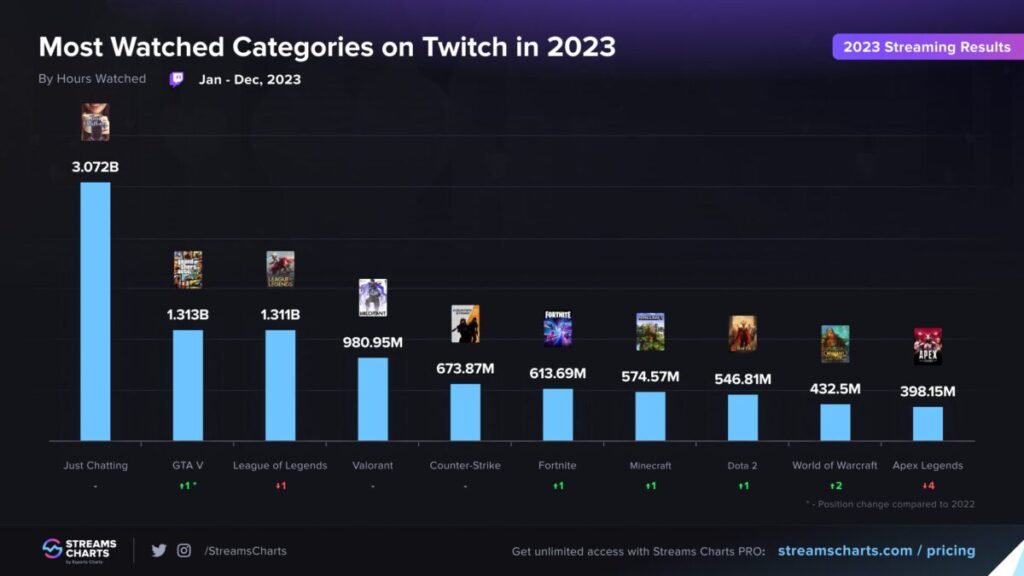Brands and game publishers attracted to Twitch’s expansive user base—240 million monthly and 35 million daily users—recognize it as an excellent opportunity for engagement. However, embarking on influencer marketing on Twitch offers a mix of significant opportunities and challenges. Notably, integrating a new game into a streamer’s established lineup can lead to a significant drop in viewer numbers—on average, by 32%.
For brands aiming to tap into Twitch’s potential for connecting with gamers worldwide, success relies on more than just recognizing the platform’s impressive metrics. Effective influencer marketing on Twitch requires a strategic approach and a thorough understanding of the platform’s nuances. In this comprehensive guide, we’ll delve into the essential steps for brands and game publishers to navigate in order to maximize the impact of their Twitch streamer partnerships.
The Insider’s Handbook: A Complete Guide for Brands to Twitch Streamer Partnerships:

Step 1: Getting To Know Twitch’s Audience
Before diving into partnerships with Twitch streamers, understanding the overlap between your target audience and Twitch’s demographics is essential.
Key insights into Twitch’s user base are crucial for ensuring alignment with your target market:
It’s also important to recognize that some game genres resonate more on Twitch. Multiplayer online battle arenas (MOBAs) like League of Legends and first-person shooters (FPS) like Valorant typically see high viewership, thanks to their competitive elements. In 2023, shooters were among the top 10 most-watched game categories on Twitch.
On the other hand, genres with less action, those not designed for competitive play, or lacking community interaction—like simulation games, turn-based strategy, or puzzles—may not achieve the same level of popularity in Twitch partnerships.
Step 2: Twitch Metrics & Benchmarks
To truly leverage Twitch streamer partnerships, understanding the platform’s specific performance indicators is key.
Twitch-Specific Key Metrics:


Average Concurrent Viewership (ACV)
This metric represents the average number of viewers tuned into a stream at any given moment and is considered a crucial indicator for streamers and brands seeking sponsorship opportunities. It calculates the average viewership by sampling the number of viewers periodically throughout the stream and then averaging these numbers over the entire stream duration.
Peak Concurrent Viewership (Peak CCV)
Peak CCV marks the highest number of viewers watching a stream simultaneously at any point during the broadcast. Comparing Peak CCV with Average CCV can provide insights into a stream’s reach and highlight moments of peak interest, despite possibly lower average viewer counts, indicating fluctuations in viewership.
Viewer-Hours
This metric quantifies the total hours of content consumed during a stream. For example, a 2-hour stream watched by 100 viewers from start to finish results in 200 viewer-hours. Calculated by multiplying the average concurrent viewership by the stream’s length in hours, viewer-hours offer a comprehensive view of content engagement, revealing not just how many watched, but how long they stayed.
Unique Viewers
Unique viewers count the total number of distinct users who watched a stream within a specific timeframe, providing a measure of the stream’s reach. A viewer is counted once regardless of how many times they tune into different streams during the selected period.
Unique Chatters
This metric counts the number of distinct users who participate in the chat during a stream, offering insights into community engagement, content relevance, and viewer loyalty. It highlights the active interaction between the audience and the streamer.
Partnerships Costs and Engagement:
Twitch is known for its exceptionally engaging environment, leading to impressive conversion rates for brands. On average, brands experience conversion rates ranging from 25% to 50% from a 2-hour sponsored stream, with particularly successful campaigns even reaching up to 70%. The cost per viewer for such streams typically falls between $2 and $5, varying by the streamer’s popularity and engagement level. For example, a streamer with an ACV of 800 over 30 days might charge between $1,600 and $4,000 for a two-hour sponsored segment.
When partnering with streamers, it’s important for brands to recognize that value per engagement forms a parabolic curve. For top tier streamers, as an audience grows, each viewer costs less due to the law of diminishing returns. On the other hand, smaller creators also offer lower rates per metric due to market saturation. So, both very popular and less popular streamers can end up costing advertisers less per engagement, but for different reasons.
For informed decision-making and maximizing return on investment (ROI), brands can use an Influencer Campaign ROI Calculator. This tool helps in estimating crucial metrics such as viewer numbers, clicks, actions taken, and overall ROI, helping brands strategically plan and fine-tune their Twitch partnership initiatives.


Step 3: Choose the Right Streamers
As of January 2024, Twitch boasted around 8.36 million active streamers, with around 3,000 games being streamed simultaneously. Picking the right streamers to promote your brand or game is crucial. Consider these key factors when scouting for Twitch influencers:


Games Played
It’s important to understand that Twitch has become an ecosystem largely driven by several extremely popular games. For example, during February 2024 15120 unique games were streamed and the top 20% of games collected 66.4% of all viewers:


Choosing streamers who focus on these popular games can be beneficial for reaching a broad gamer audience. However, for targeting specific niches, it’s essential to find streamers whose game choices align closely with your product or who are known for streaming a variety of games.
Niche vs. Variety Streamers
For reaching niche markets, select streamers specializing in games closely related to your product. On the other hand, if your aim is a wider audience, consider partnering with Variety streamers. These streamers appeal to diverse viewership as they play multiple games. Research indicates that only 30.4% of streamers with an average concurrent viewership (CCV) between 100 and 10,000 stick to a single game, and the most popular channels often feature at least 10 different games.
Performance
Brands tend to favor well-known streamers due to limited data and platform understanding, a strategy that might be expensive and not always effective due to potential overuse and diminished relevance for their brand. Instead of just considering follower counts, assessing streamers by their average viewer numbers and engagement levels offers a more insightful approach. A study categorizing streamers by viewer average found distinct performance based on audience size. Here’s a summary:
1. Rising Stars (Micro Streamers)
Average CCV: up to 2K
These streamers typically attract smaller audiences, with some focusing deliberately on niche genres while others struggle to retain a broad viewer base. This category includes creators fostering communities around specific identities or experiences (like transgender streamers) or dedicated topics (such as those focusing on a single game). Non-gaming channels, like IRL, talk shows, and creative content, are also prevalent here.
Benefits of partnering with Micro-Influencers: pluses of partnering with a micro-influencer is that they’re most likely still growing their channel so you can get a more affordable campaign with them + they allow for very precise niche targeting.
2. The ChatterBoxes (Mid-Tier Streamers)
Average CCV: 2K – 8K
Streamers in this tier consistently engage significant viewership, averaging around 4,500 viewers per stream. The development of unique slang and emoticons indicates a strong community identity. Typically, one person plays live while another interacts with the chat, encouraging in-depth dialogue with viewers.
Benefits of partnering with Mid-Tier streamers: Partnering with Mid-Tier Streamers offers brands not just extended reach but also a chance to tap into highly engaged and trustful communities, thanks to the streamers’ active viewer interaction.
3. Spotlight Streamers (Macro Streamers)
Average CCV: 8K to 22K
Streams in this segment are highly promoted by Twitch (featured on the home page) and have large audiences but retain relatively few of their new viewers. Many viewers engage in chat only briefly, despite the streamer’s large following. Streamers in this group are highly focused on the gameplay and not necessarily highly engaged in conversations with their audience.
Benefits of partnering with Macro streamers: The significant viewership of these streamers means that sponsored content and brand messages can reach a large audience quickly. Being featured on Twitch’s home page further amplifies this exposure, providing prime real estate for brand visibility.
4. Celebrities (Mega Streamers)
Average CCV: starting at 22K
Streamers in this segment are typically professional Twitch streamers and are among the top players of a particular game. The most popular tournament streams also fall into this category. They stream for long periods of time (4 hours or more in a session) and typically play one of the top 5 most popular games on Twitch. The interchange of low-content messages in the chat creates a sense of “crowdspeak”, where audiences are communicating similar to that of a stadium/crowd environment.
Benefits of partnering with Mega Streamers: As top players and often participants in popular tournaments, Mega Streamers carry significant influence and authority within the gaming community, making their endorsements highly impactful.
Activity
Consistency plays a crucial role in a streamer’s success on Twitch. The platform’s live nature demands a high level of commitment and discipline from streamers, as they can’t just post content at their convenience like on pre-recorded platforms. Viewers have set expectations for live availability. Research indicates that streamers who go live at least 5 times a week and accumulate over 40 hours of streaming time tend to achieve the best outcomes.
To gauge a streamer’s consistency and dedication, consider the following metrics:
- Weekly Active Days measures the average number of days a channel has streamed per week within the last 30 or 60 days.
- Average Daily Streaming Time reflects the average length of each stream session per day across the last 30 or 60 days.
Step 4: Boost Campaign Effectiveness
To enhance the effectiveness of Twitch streamer partnerships, brands can leverage a range of tools and tactics. Here are some of the best practices:


1. Twitch Drops
Twitch Drops are a feature that game developers and publishers use to reward Twitch viewers for watching streams of their games. Drops offer viewers the chance to earn in-game items, rewards, or exclusive content simply by watching live streams of their favorite games on Twitch. This system benefits both game developers and the Twitch community, enhancing viewer participation and offering rewards for time spent watching streams.
Developers specify how much viewing time is required for each Drop, and as viewers tune into participating channels, their watch time accumulates towards unlocking these rewards. Twitch Drops gain significant traction around game releases, major updates, or esports tournaments, making them a key strategy for drawing in and keeping an audience engaged. This feature not only helps streamers reach new viewers who may not have found their channels otherwise but also enhances viewer retention. All ongoing Drops campaigns and the channels involved are showcased on a special page, making it easy for users to explore active Drops and connect with new content.
2. Early Access
In the gaming world, initial sales are crucial. They’re not just indicators of a game’s immediate financial success but also shape its future in terms of profit, popularity, and support. To boost Day 1 sales, companies employ strategies to build hype and support, similar to the film industry’s focus on opening weekend performance.
An Early Access campaign on Twitch refers to a promotional strategy where game developers partner with Twitch streamers to showcase their games before they are officially released to the general public. This approach allows viewers on Twitch to get a first look at gameplay, features, and content of upcoming games directly through their favorite streamers’ channels.
Early Access campaigns on Twitch effectively bridge the gap between game developers, streamers, and the gaming community, leveraging the platform’s interactive and live-streaming capabilities to maximize exposure and engagement for upcoming game titles.
3. Chat Box Messages
Collaborating with streamers to create custom chat commands related to the brand or campaign can trigger automated messages with information or links. For example, typing “!newproduct” in chat could provide viewers with a link to a new product launch. Some streamers offer sponsorship opportunities where your brand’s messages can be highlighted or pinned in the chat for a period, ensuring higher visibility among the stream’s viewers.
Brands can also sponsor chat messages that are interactive and engaging. These can be polls, quizzes, or links to brand-related content. By doing this, brands capture the attention of viewers actively participating in the chat.
4. Info Panel Banners
Located below the video player, info panels serve as a permanent space for brands to place banners, links, and detailed descriptions. Unlike the transient nature of chat messages, info panels provide lasting visibility. These banners can be tailored to fit the brand’s current campaigns, promotions, or product launches. They can include eye-catching graphics, calls-to-action (CTAs), and direct links to the brand’s website or specific landing pages. For streamers participating in affiliate programs, info panel banners can feature affiliate links to products or services. This is a direct way to drive sales or actions from Twitch viewers.
5. Twitch Extensions
Developing or sponsoring a Twitch Extension, which are interactive overlays and panels, can offer utility, entertainment, or additional content related to your brand directly on the stream. These extensions can overlay the stream itself or facilitate chat interactions. The possibilities with Twitch Extensions are boundless – from crafting a mini-game to influencing the gameplay of the streamer. Streamers appreciate extensions for their ability to foster direct engagement with their viewers.
For example, Stream Avatars, available on Steam for a modest fee, introduces an engaging interactive element to the stream. It grants viewers their avatars that wander across the bottom of the screen. With options to host mini-games and extensive customization capabilities, it offers a dynamic way to enhance viewer interaction and fun during your broadcasts.
Here is a guide for discovering innovative extensions that can enhance streaming experience, engage viewers, and add unique functionalities to your sponsored Twitch stream.
6. Stream Schedules
With Twitch boasting over 2.5 million viewers at any moment, timing your streams effectively is key to maximizing audience reach.
Sundays attract the highest number of viewers on Twitch, while Mondays see the least activity. Hootsuite’s data suggests the prime streaming window is from 11 a.m. to 2 p.m. Pacific Standard Time (PST), coinciding with peak audience presence. TwitchTracker indicates the platform hits its viewer peak at 1:00 p.m. Pacific Standard Time (PST), with the lowest viewership 12 hours later, at 1:00 a.m. PST.
To capitalize on these insights, brands that sponsor larger channels should aim for sponsored streams during peak times to capture the widest audience. On the other hand, brands who partner with smaller channels might find opportunities by streaming from 12 a.m. to 4 a.m. PST when there are fewer live streams and thus less competition for viewer attention.
7. Stream Duration
Twitch data reveals that most streamers go live for durations ranging from 90 minutes to 3 hours. Streaming for shorter periods narrows the discovery window for potential viewers. Research indicates streaming for less than 6 hours tends to yield the best follower growth rate per hour, with streams lasting over 24 hours showing diminished returns on follower growth. Hence, brands would benefit from partnering with streams lasting between 90 minutes and 6 hours for optimal efficiency.
A strategic tip for streamers is to start their sessions with alternative content before switching to the sponsored game, recommending at least a 30-minute engagement with different content. This tactic leverages the pattern where viewership usually ramps up after the initial 30 minutes, securing a broader audience for the sponsored game and enhancing the promotion’s effectiveness on Twitch.
Step 5: Learn from Findings and Refine Your Strategy
After executing Twitch streamer partnerships, it’s essential for brands to analyze campaign performance metrics and gather insights to inform future strategies. Tracking metrics such as average viewership, engagement rates, and conversion rates can provide valuable insights into campaign effectiveness and audience preferences. By iteratively refining their approach based on data-driven insights and feedback from partners, brands can continuously optimize their Twitch marketing strategies and drive sustainable growth in the dynamic gaming industry.
Conclusion
Twitch streamer partnerships offer brands a powerful platform to connect with gaming audiences and drive meaningful engagement. By following the steps outlined in this comprehensive Twitch guide and leveraging the latest statistics and insights, brands can navigate the intricacies of Twitch marketing with confidence and create impactful campaigns that resonate with viewers. As the gaming industry continues to evolve, embracing Twitch as a strategic marketing channel can position brands for long-term success and establish a strong presence in the ever-expanding world of online gaming.


